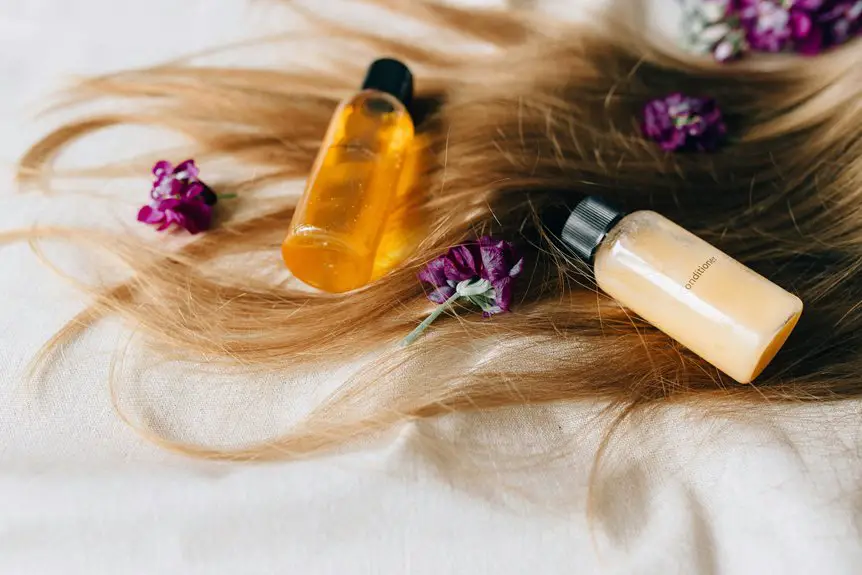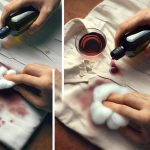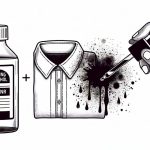To remove hair dye stains from upholstery, first identify your fabric type to choose the safest cleaning method. Blot the stain immediately with a clean cloth to soak up excess dye—don’t rub. Use a mild soap and warm water solution or try vinegar or rubbing alcohol on a hidden spot first. If needed, apply a commercial upholstery cleaner made for tough stains. Taking these quick steps can save your furniture, and there are more tips to help protect your upholstery in the future.
Table of Contents
Key Takeaways
- Identify your upholstery fabric type and check manufacturer’s cleaning codes before applying any stain removal method.
- Blot the hair dye stain immediately with a clean, dry cloth to absorb excess dye without rubbing or spreading it.
- Use a mild dish soap and warm water solution or white vinegar on a cotton ball to gently blot and lift the stain.
- Test any cleaning solution or commercial upholstery cleaner on a hidden area first to avoid fabric damage or discoloration.
- Prevent future stains by covering furniture during dyeing and keeping stain removers handy for quick treatment.
Identify the Type of Upholstery Fabric
Before you tackle hair dye stains, you need to identify the type of upholstery fabric you’re dealing with. Different fabrics react differently to cleaning agents, so knowing yours helps prevent damage.
Check the manufacturer’s tag if you can; it often lists the material or a cleaning code. Natural fibers like cotton or linen absorb stains quickly but respond well to water-based cleaners.
Check your manufacturer’s tag for fabric type or cleaning codes to choose the best stain removal method.
Synthetic fabrics such as polyester or nylon are more stain-resistant but might require specific solvents. Delicate fabrics, like silk or velvet, need extra care and usually professional cleaning.
If you’re unsure, test a small, hidden area with water or a mild cleaner first. Identifying your fabric correctly guarantees you choose the safest and most effective method to remove hair dye stains without ruining your upholstery.
Act Quickly to Blot the Stain
Once you know your upholstery fabric, act quickly to blot the hair dye stain before it sets.
Grab a clean, dry cloth or paper towel and gently press it onto the stained area. Don’t rub or scrub—the last thing you want is to spread the dye or push it deeper into the fibers.
Instead, use a blotting motion, lifting the excess dye away from the fabric. Replace the cloth as it absorbs the stain to avoid reapplying the dye.
The faster you act, the better your chances of preventing the stain from becoming permanent.
Use Household Cleaning Solutions
Several common household items can help you tackle hair dye stains effectively.
Start by mixing a solution of mild dish soap and warm water. Dip a clean cloth into the mixture and gently blot the stained area—avoid rubbing, which can spread the dye.
If the stain persists, try applying a small amount of white vinegar or rubbing alcohol to a cotton ball and dab it on the spot. These solutions break down the dye without damaging most upholstery fabrics.
Always test any cleaning solution on a hidden area first to verify it won’t discolor your fabric.
After treating the stain, blot with a clean, damp cloth to remove any residue, then let the upholstery air dry.
Using these household solutions quickly can greatly improve your chances of removing hair dye stains.
Try Commercial Upholstery Cleaners
Explore commercial upholstery cleaners designed specifically to tackle tough hair dye stains. You’ll find products formulated to lift dye without harming your fabric. Before applying, test the cleaner on a hidden spot to verify it won’t discolor or damage the upholstery. Follow the instructions carefully for best results. These cleaners save time and effort, especially when household solutions fall short.
| Cleaner Type | Ease of Use | Confidence Level |
|---|---|---|
| Spray & Wipe | Quick application | High for fresh stains |
| Foam Cleaner | Gentle action | Medium, may require repeat use |
| Gel Cleaner | Targeted treatment | High, ideal for stubborn spots |
Using commercial cleaners can restore your upholstery’s look and ease your worry.
Prevent Future Hair Dye Stains
Although accidents happen, you can take simple steps to prevent hair dye stains from ruining your upholstery in the future.
First, always cover your furniture with old sheets or plastic when dyeing your hair at home. Wearing an old shirt and using a cape or towel around your shoulders helps, too.
Be mindful when applying hair dye—try to do it near a sink or in a well-protected area. If you have frequent touch-ups, consider using washable slipcovers that you can remove and clean easily.
Finally, keep stain removers or cleaning wipes nearby so you can act quickly if a spill occurs. Taking these precautions will save you time, money, and the hassle of dealing with tough stains later on.
Frequently Asked Questions
Can Hair Dye Stains Cause Permanent Damage to Upholstery Fabric?
Yes, hair dye stains can cause permanent damage to your upholstery fabric if you don’t act quickly. The chemicals can set and discolor fibers, making the stain nearly impossible to remove later on.
Are Natural Hair Dyes Less Likely to Stain Furniture?
Natural hair dyes usually stain furniture less because they contain fewer harsh chemicals than synthetic dyes. But you’ll still want to act quickly if you spill, since some natural pigments can leave marks too.
How Long Does It Take for Hair Dye Stains to Set Permanently?
Hair dye stains usually start setting within 10 to 30 minutes, but they can become permanent after an hour or so. The longer you wait, the harder it is to remove them completely from fabric.
Can Professional Upholstery Cleaning Remove Old Hair Dye Stains?
You’d think old hair dye stains are impossible to erase, but pros can often work miracles! They use powerful cleaners and techniques you can’t match, so chances are, they’ll remove even stubborn, set-in stains from your upholstery.
Is It Safe to Use Bleach on Upholstery Fabric for Dye Stains?
You shouldn’t use bleach on upholstery fabric; it can damage fibers and cause discoloration. Instead, test a mild cleaner on a hidden spot first, and consider professional cleaning to safely handle tough dye stains without ruining your fabric.
- The Benefits of Using Nonwoven Wallpaper in Your Home - July 11, 2025
- Nonwoven Fabric vs. Paper: A Comparison of Properties - July 11, 2025
- The Role of Nonwoven Fabrics in Filtration Systems - July 11, 2025





